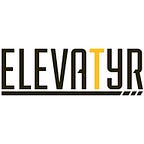Profiling the Elevatyr Core 12: How Qtum is Helping the World Adopt Blockchain
Qtum is a platform meant to bridge the gap between Bitcoin and Ethereum, while making blockchain technology more approachable for companies looking to incorporate it into their business.
It was first built as an ERC-20 token on top of the Ethereum blockchain, and has now been moved over to its own Main Net. The Qtum chain is programmed like a mix of Bitcoin and Ethereum, with interoperability for both.
The chain uses Bitcoin’s code to write its transactions and the Ethereum Virtual Machine to process its smart contracts. Qtum is governed by a Proof of Stake consensus, similar to the one made by dash, where community members who hold Qtum can stake their coins to hold down the network and have a vote in how the platform operates.
Interoperability is key.
With Qtum you’re able to write smart contracts that can be operated on the Qtum chain, the Ethereum chain, or use Ethereum smart contracts to move Bitcoin. The idea being that, with Qtum, all of these blockchains, and new ones to come, can work together to make back end use as good for the company as they make it for the users.
Qtum is focused on bringing blockchain to regular businesses. While the technology will eventually become mainstream, this team is pushing businesses with outdated systems to upgrade to blockchain in order to increase efficiency, mixing blockchain technologies to allow for light clients, and have made their platform more accessible so that it can be built on too.
Business Savvy
Qtum’s quality is based in part because of its business focused approach to adoption.
Blockchain platforms often focus on end user popularity because, in the media driven world we live, popularity often means increased exposure and possible businesses. You’ll see platforms hold conferences and meet ups trying to keep the community excited so more developers will want to work, but Qtum focuses on the real.
Qtum has over 7,000 active nodes all around the world in order to help businesses seamlessly integrate their existing systems with the blockchain. The team works backwards with these companies, reverse-engineering their antiquated processes to retrofit them for the blockchain.
The platform protocol sector of blockchain is still extremely young. The majority of platforms are trying to tell businesses that they need a flat screen 3D TVs, when all that’s out right now is the radio. Qtum is actively searching for businesses that look like they could use a radio, offering to install it for them, and working on updates to make them a TV.
It would be great if things went straight to 3D flat screen TVs but further progress often requires adoption of what’s already been made.
Smart Phones and Blockchains
Blockchain is often referred to as immutable ledger technology. This describes how all of the Bitcoin transactions are kept on a public list that can’t be changed. That list is kept secure by network nodes, which are public copies of the list that are held by individuals and checked by the other nodes on the network.
A platform with smart contracts usually requires the power of a full node to write and execute a smart contract. In other words, you need a copy of the list of transactions in order to make a contact.
Smartphones and blockchains don’t get along because super efficient portable devices aren’t built to hold ledgers with millions of transactions on them, and therefore can’t have DApps on them create smart contracts.
Qtum fixes this problem with the use of a light client. Think of the light client as a partial node. It keeps the records of the past few blocks as well as information about any transactions relevant to your account.
Using a light client to put blockchain DApps on iPhones doesn’t sound like a breakthrough, but the interoperability of Qtum with Ethereum and Bitcoin, means that an Ethereum Dapp could easily run on the Qtum chain while having the same security and using the same language as Ethereum.
Oracles
We can’t get stuck thinking that the technology that was just developed is the most high tech. Customers often want the most advanced products, but fail to see if that product will be compatible with the next generation of its kind.
To prepare for this Qtum uses something called an oracle. Oracles help connect blockchain the the real world. Smart contracts often are dependent on real world occurrences, such as “Did the boat arrive at the port?” or “Is it likely going to rain today?” Oracles help convert real world data into smart contract action.
Oracle: “Yes it is going to rain today” Smart Contract: “Close the sun roof”
Any device looking to receive information from a Qtum smart contract can do so with the proper permissions, no matter what chain they’re on. This leaves the Qtum platform open for development, and because it’s so closely integrated with Ethereum and Bitcoin, it opens up their platforms for development as well.
QTUM can be traded on select cryptocurrency exchanges, and will be available for trading via Elevatyr, which will be entering an early access period in July. Visit https://www.elevatyr.io/ to sign up for the closed beta waitlist, and to learn more about how Elevatyr is the simplest way to intelligently trade cryptocurrencies.
For those interested in learning more about QTUM, you may visit Ethereum Classic’s website at https://qtum.org/en
Disclosure: This article does not represent an endorsement of the QTUM cryptocurrency as an investment, and is for informational purposes only. Trading decisions should be made on an individual basis, and be informed by independent research. Elevatyr makes no recommendation as to trading behavior that should or should not be taken. The author of this article owns a small stake of QTUM cryptocurrency.
